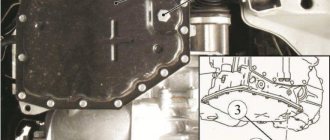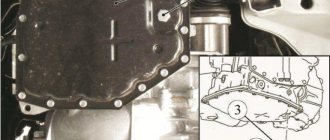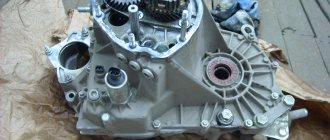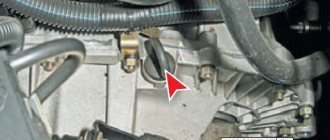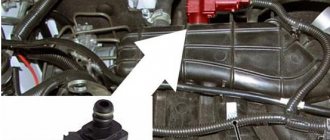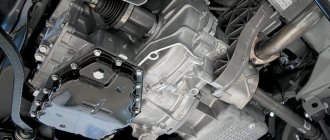Timely replacement of transmission fluid in a car's gearbox will extend the life of your vehicle, improve performance and avoid a number of serious problems that can lead to serious damage or complete failure of the unit.
Over time, the oil in the box loses its original chemical and physical properties. Liquid used for a long time is not able to adequately cool the gears that heat up during friction, which leads to their rapid wear. In addition, driving the Kalina becomes less comfortable.
In this article we will tell you how to change the oil in a Kalina gearbox, how much fluid to fill, how to check the level, and also give useful tips and instructions.
When to change the gearbox oil for Lada Kalina
The documentation from the factory does not contain clear regulations for updating or completely replacing the transmission fluid. In this regard, many car owners believe that the volume filled at the factory will be enough to last the entire time the car is used. The result of this attitude is a quick visit to the service station for major repairs.
Experts disagree on how often the oil should be changed in the Lada Kalina gearbox, no matter the 2nd cable model or the old model. Some give as guidelines a mileage of 70-75 thousand km or 5 years of operation, others insist that the fluid will be enough for 120-150 thousand km.
Of course, the distance your car has traveled and how long ago it was purchased are not all the parameters that should be taken into account. If you are forced to often stand in traffic jams or drive at low speeds, the transmission fluid may become unusable even after a mileage of 40-50 thousand km.
Carry out diagnostics immediately if you begin to notice deviations in the operation of the gearbox (noise, hard shifting).
Replacement frequency
If we proceed from the recommendations of the automaker itself, represented by the AvtoVAZ company, then there is no specific frequency and period for changing the oil in the gearbox of the Lada Kalina car. According to their beliefs, it is not necessary to change the transmission lubricant in the gearbox; it is enough for the entire period of operation of the machine. In practice, the actual operating conditions of the vehicle significantly reduce the service life of the oil filled from the factory. Experts came to the conclusion that in order to maintain the efficiency and performance of the gearbox, it is better to replace it at least once every 50 - 80 thousand kilometers. If you use the machine less actively, then the frequency is determined in years and is no more than 4 - 5 years.
If you haven’t driven about 50-70 thousand kilometers in 4 years, it’s still better to change the oil. It would be most correct to start from the current state of the transmission fluid. To do this, periodically check the oil, measure its level, top up, and if the lubricant wears out, change it completely in the Kalina gearbox.
If the oil is not changed in a timely manner, you risk encountering:
- Wear of shafts and gears. This happens because the lubricant loses its original physical and chemical properties and stops cooling the parts. Further rotation of the elements provokes friction and overheating.
- Loss of chemical properties. This is where parts begin to wear out and metal shavings appear, which negatively affects the bearings.
- Failure of the entire gearbox. Carrying out a major overhaul or completely replacing the box in Kalina will not be such a cheap pleasure.
The consequences are really serious and costly for the car owner’s wallet. Therefore, it is better to periodically check the oil and change it on time.
Changing the oil in the gearbox of Lada Kalina 2nd generation: level measurement
There are two ways to measure how much transmission fluid is in the gearbox of your Lada Kalina:
- Using a dipstick.
- By completely draining.
Regardless of how exactly you are going to measure the oil level, the car engine must first be warmed up. At an air temperature of 20°C, you will have to drive for 10 minutes for the transmission fluid to warm up to 50-80°C.
The procedure for measuring the oil level with a dipstick:
- Move out the air filter.
- Find the dipstick (it's located to the left of the motor), pull it out and wipe it thoroughly.
- Place the dipstick in place, wait a few seconds and remove it.
- Determine the volume of oil in the Kalina gearbox using the oil trail.
The probe has two notches: “min” and “max”. If the level is below the minimum mark, you should change the oil in the Kalina box, both 8 and 16 valve. If the indicator approaches “min”, adding at least 200 grams will be necessary.
To measure the liquid level by completely draining it, you will need an inspection hole, as well as a funnel and an empty 4-liter container.
After installing the vehicle over a hole or overpass, perform the following operations:
- Remove the air filter.
- Unscrew the lower engine protective cover.
- Open the drain cap and drain the oil (this process may take 30-40 minutes).
Upon completion of the draining procedure, evaluate the volume of oil in the Kalina box and its quality. The oil should be transparent and free of sediment and metallic inclusions. If the amount of fluid and its condition are normal, pour the oil back in.
Dark color and the presence of chips means that the gearbox requires flushing with special flushing oil. After this is completed, pour in new transmission fluid.
Why does it wear off?
The situation when the Kalina gearbox dipstick wears off occurs for two reasons:
- incorrect installation in the seat;
- meter defect (manufacturing defect, bending).
In these cases, one edge of the rod is “eaten” in the area of the MAX and MIN marks.
Grinded oil dipstick
During operation, the rubber from which the cork is made loses its properties, becoming too hard. This leads to loose fixation of the hole plug. Therefore, the probe becomes loose in the box.
How and where to store transmission fluid
Before use, make sure that the oil has not yet expired. To do this, refer to the label on the container. To keep your gearbox fluid in optimal condition, you will need to follow these instructions:
- Close the cap of the bottle or canister tightly. The product must be stored in airtight packaging.
- Do not leave containers in the sun or direct light. A suitable place for storage would be a cellar, attic, garage, etc.
- Check the expiration date.
- Do not store lubricant containers in a room with temperatures above 24 degrees Celsius. Otherwise, the chemical elements of the oil may change and harm the box.
- Do not allow excess moisture to get inside the liquid container.
Purpose and design
The main function of the oil pressure sensor in Kalina is to inform the driver about the presence of oil pressure in the engine. The sensor is a valve that opens its contacts at a certain pressure.
When you turn on the ignition, you can see a red oil can on the car’s dashboard; it indicates that there is now no oil pressure in the engine, and this is correct, because the internal combustion engine is not running. Once the starter starts rotating and the engine starts, the light should go out within a few seconds. If this does not happen, then there is no oil pressure in the internal combustion engine, which can lead to engine damage.
What oil is better to fill in the Lada Kalina box?
AvtoVAZ equips vehicles with different gearboxes. The first generation Kalina is available with a manual transmission 1118 or 1119, the second generation - with a manual transmission 2180 or 2181. In addition, some Kalina 2 models have an automatic transmission; as a rule, manufacturers use automatic transmissions manufactured by Nissan.
How much oil to pour into the Kalina gearbox? The boxes differ in volume: the smallest will be in the manual transmission 2181 - 2.2 liters; the largest - up to 3.5 in manual transmissions 1118 and 1119.
At the factory, gearboxes of all types are filled with the same fluid: TNK TRANS KP mineral oil, produced by the Ryazan Oil Refinery. At the same time, the manufacturer does not insist on using this brand exclusively.
The most important factor is that the liquid performs the required functions:
- protection of surfaces exposed to friction from wear and wedge;
- reduction of shock load;
- reduction of energy losses due to friction;
- reduction of hum and vibration of gears.
To ensure the correct functioning of the Lada Kalina gearbox, the lubricating fluid must have the following parameters:
- anti-corrosion and anti-wear properties;
- increased oxidation stability;
- excellent viscosity-temperature criteria;
- compatibility with rubber gearbox parts;
- low foaming;
- stability of the chemical composition.
An indicator of the quality of the product will be its compliance with API standards (it must have a class of GL-4 or GL-4/5), as well as the viscosity standard SAE J 306. The latter regulates the optimal option for various temperature conditions.
Which oil is best for the Kalina gearbox? The Lada owner must independently choose a lubricant in accordance with the climatic characteristics of his region:
- SAE 75W-80 and 75W-85 (from -40°C to +35°C).
- SAE 75W-90 (-40°C to +45°C).
- SAE 80W-85 (-26°C to +35°C).
- SAE 80W-90 (-26°C to +45°C).
- SAE 85W-90 (from -12°C to +45°C and above).
Oils used
If you took the Lada Kalina from the factory and did not change the transmission oil yourself, then Magnum 300 lubricant from TNK was probably filled inside it. This is a standard liquid poured into the box at Kalina production. And in Kalina 2 they already use Kinetic SAE from the Rosneft company. Therefore, make sure what kind of car you have and what was initially filled there if you are just going to add fluid.
is mineral, which can hardly be called high-quality and effective. In terms of characteristics, it is significantly inferior to many competitors. The reason for its use has a lot to do with its cheapness. It is optimal to change it to a semi-synthetic one, which will allow the box to feel comfortable under any operating conditions. According to car recommendations, it is better to use the following oils:
- TM4 produced by Lukoil;
- Kinetic company Rosneft;
- Trans KP from Novoil;
- Translux TM4-12 from Tatneft;
- Trans KP and LZ Super produced by TNK;
- Transaxle from Shell.
Useful tips
The first and most important recommendation is not to use mineral compounds when operating the car in low temperatures. This type of oil tends to thicken, as a result of which the gearbox gears do not receive proper lubrication and lock up. This is due to the fact that the viscosity of the frozen composition does not allow them to work correctly. It is advisable to use such a liquid only in areas with a constantly warm climate.
Periodically check the oil level in the box. It won't take too much time, but at the same time you will be sure that one of the most important components of your vehicle is working correctly. If you notice that the lubricant is leaving or leaking, immediately contact the service for diagnostics.
There are a large number of gearbox fluids on the market that meet the listed requirements. When choosing a specific oil, the owner of a Kalina car will be faced with the question: is the use of an expensive imported product justified or for a domestic vehicle the best option would be a cheaper Russian-made fluid.
Which lubricant should you choose?
Today there is no shortage of choice of transmission fluids; the main thing is to purchase the original, and not the Chinese analogue. Many users, having used a Lada Kalina car, recommend Lukoil semi-synthetics, TNK Magnum - oils that allow you to travel up to 300 thousand km. without major repairs. At the same time, the manual transmission behaves much quieter, switching gears more smoothly in cold weather.
Those who operate a Lada Kalina 2 car should be guided by the type of transmission (manual transmission or automatic transmission) and the attached documentation when choosing oil. It should be remembered that when using oils other than those recommended by the manufacturer, failures and malfunctions in the functioning of the automatic transmission are possible. These faults are not subject to warranty repair.
Lada Kalina Gearbox oil change
Change of oil
at
Lada-
Kalina
checkpoint in pictures with comments. Engine 1.6. 16V.
It is better to change the oil immediately after a trip, while it is hot, so the oil combines faster and more fully with suspended wear particles.
The temperature of the heated oil reaches 90 °C, be careful.
1. We prepare the car for work
2. Place a container under the drain hole of the crankcase.
3. 17 spanner, unscrew the drain plug.
4. Drain the oil.
5. After waiting for the oil to completely drain from the box, screw the plug to the area.
If the oil drained from the box is dark in color and iron particles are noticeable, the box should be washed. For this purpose, pour 1-1.5 liters of special flushing oil into the crankcase. With one of the drive wheels hanging, start the engine and engage first gear. After 5-7 minutes, turn off the engine, drain the flushing oil and fill in clean transmission oil.
How to check the oil level in a grant gearbox.
6. We take out the oil level indicator.
7. We wipe the pointer, removing oil from it.
8. We thread the lower end of the hose into the hole of the oil level indicator.
9. Insert a funnel into the upper end of the hose.
10. Through a funnel, pour 3.1 liters of gear oil into the gearbox.
We control the oil level in the box using the indicator.
11. At the end of the work, use a rag to remove oil leaks and install the oil level indicator at its intended location.
Checking volume and condition
There are two main ways to check the oil volume in the Kalina gearbox.
- With a feeler gauge. This is a traditional method that is used to assess the transmission oil fill and condition of a gearbox. The dipstick is pulled out, wiped, inserted back, and removed. Then we focus on o and “Max”. The level is normal if the oil is approximately halfway between the two marks.
- Full drain method. This check of the oil level in the gearbox of a Lada Kalina car is relevant if you are going to change it. The liquid is completely drained into the container, and new lubricant is poured in instead.
Both methods have the right to life. But one is preventative, and the second is usually used during repairs or routine replacement of transmission oil. If we talk about how much oil is in the Kalina gearbox, then it requires approximately 3 liters. But experienced car owners of domestic cars recommend having a reserve of 1 - 2 liters. The first fill will take about 3.1 liters, and subsequently you will have the appropriate oil to add as the lubricant level gradually decreases.
It is recommended to carry out a preventive check of the condition and level every 10 thousand kilometers. You can do it more often, it definitely won’t make it worse. To assess the condition, simply drop oil onto a white surface (paper, rags) and look at it visually. You can compare it to fresh oil by dropping it nearby. If there are any impurities in the old lubricant, or the color has noticeably changed, it is better to change it.
Features of checking the oil level on a cold and hot engine
There are so-called two castes of drivers, some claim that it is best to check the oil level on a cold engine, others, on the contrary, on a hot one. But the truth, as often happens, is in the middle.
IMPORTANT: The situation described below is when the dipstick does not have the “cold” and “hot” check marks.
As we know from physics and chemistry, any substance contracts in the cold and expands at high temperatures. This also applies to motor oil.
Let's imagine a situation where measurements are carried out on a cold engine at a temperature of minus 100C. The oil is compressed and its level on the dipstick has moved down. They topped it up as stated in the car's operating manual and warmed up the engine.
As a result, the working fluid warmed up, expanded and occupied a larger volume. Those. the level has become elevated (the consequences of this are described above).
If you take level measurements immediately after stopping the engine, the oil will not have time to drain into the crankcase and the readings will be incorrect. You need to wait a few minutes until the still heated and not very viscous liquid drains into the crankcase.
At the same time, it will cool down a little, but this will not greatly affect the accuracy of the measurement results. And what’s important is that this method can be safely used both in winter and summer.
Also keep in mind that non-original (fake) oils “behave” differently - they can harden like jelly even in hot summer weather.
Features of the transmission in the Kalina model
If we touch on the design aspects of the box installed on the second generation of the practical Lada Kalina, we should designate the locking solenoid. This element is present in the unit to prevent accidental engagement of reverse gear while driving forward. You will not be able to activate reverse speed when the electrical circuit of this solenoid is broken or the component itself has become unusable. If there is a malfunction, repairs will be required.
In this case, unscrew the solenoid from the transmission housing. We install a special locking plug in its seat. It can be found in a repair kit, which is recommended to be kept in stock in the car. This allows the owner to get to the repair site. You will need to move very carefully in such a situation. We take special care not to accidentally engage reverse instead of one of the forward gears.
It is not difficult to carry out the repair operation yourself, but you will need a gear shift diagram.
Transmission – automatic Kalina
The manufacturer equips its creation with a fairly modern automatic transmission. This gearbox device is used only with the 1.6-liter 16-valve version of the engine.
Note that all modifications that the manufacturer has equipped with an automatic transmission have a reduced ground clearance. Also, the engine sump in this version is covered from below with an aluminum protective shield.
The gearbox is characterized by its own features, which allow the LADA Kalina car to have increased fuel consumption and slightly reduced dynamics. The unit, in comparison with the mechanical version, has more mass, which also provokes an increase in fuel consumption and the total weight of the model.
Mechanical transmissions of LADA Kalina have a cable-type shift mechanism. When the owner notices a loss of clarity during switching moments, the condition of the scenes should be immediately assessed. In the best case, the fixing nut has loosened, as a result of which there is a displacement of the link due to unsatisfactory fastening of the clamp present here.
Let us note one more important problem. It consists in the fact that when the engine speed reaches 3000 per minute, the effect of the lever rattling occurs. Here you will need to resort to shortening the sleeve. This measure will reduce the size of the gap, after which the handle will “leave the habit” of dangling. We take a file, sharpen the indicated sleeve a little and lubricate the assembly. The lever is now held tighter.
Clutch and brake sensors
Based on the signals from the clutch pedal position sensor and the brake light switch, the controller distinguishes between pressed and unpressed pedal positions. When the clutch pedal is pressed, the controller disables engine load regulation. Both sensors are located on the pedal assembly.
See "Replacing and Inspecting the Clutch Pedal Sensor" and "Replacing and Inspecting the Brake Pedal Sensor."
Some vehicle versions use an electronic throttle valve drive (E-gas). Let us remind you that in order to understand what errors are recorded in the ECU, you need to decipher them.
Keywords: Lada Granta sensors | Lada Kalina sensors | Lada Priora sensors | Lada Granta engine | Lada Kalina engine | Lada Priora engine | Lada Vesta sensors | Lada Largus sensors | 4x4 sensors | lada xray sensors | lada xray engine | Lada Vesta engine | Lada Largus engine | 4x4 engine | ECM Lada Vesta | ECM Lada XRAY | ECM Lada Largus | ECM Lada Granta | ECM Lada Kalina | ECM Lada Priora | ECM 4x4 | Niva sensors | Niva engine | esud niva | universal article
Found an error? Select it and press Ctrl+Enter..
Consequences of incorrect oil level
There is an opinion among inexperienced drivers that the more oil is poured into the engine, the better, since there is no need to check it often.
But it is important to understand that if the lubricating fluid is above the upper mark of the dipstick, then its excess will enter the crankcase ventilation system, and this is dangerous for the catalyst.
This can also lead to an increase in pressure in the lubrication system, and this, in turn, can adversely affect the condition of the gaskets and seals and subsequently lead to their extrusion.
Due to the low level of working fluid, air is sucked into the oil pump, i.e. some engine parts will run dry, and this will reduce the interval until the unit is overhauled.
Also, during the measurement, you can check the condition of the lubricant and replace it in time, and this is also important.
How the dipstick works
There is no point in considering the design of the probe itself, everything is clear here, let's talk about the marks, because you need to navigate by them when taking measurements.
Most car brands follow one principle: the lower mark L is the minimum level, the upper mark F is the maximum. The designations “MIN” and “MAX” may also be found.
Also on some dipsticks there are marks for measuring the oil level at cold and hot.
But that’s not all; in order to measure readings correctly, you need to adhere to certain rules and conditions, which we will talk about below.
Purpose and design
The main function of the oil pressure sensor in Kalina is to inform the driver about the presence of oil pressure in the engine. The sensor is a valve that opens its contacts at a certain pressure.
When you turn on the ignition, you can see a red oil can on the car’s dashboard; it indicates that there is now no oil pressure in the engine, and this is correct, because the internal combustion engine is not running. Once the starter starts rotating and the engine starts, the light should go out within a few seconds. If this does not happen, then there is no oil pressure in the internal combustion engine, which can lead to engine damage.
Where is
Many people wonder where the oil pressure sensor is on Kalina, but it’s really hard to notice right away. Also, the location of the sensor depends on the type of engine, namely on the number of valves.
- On the 16-valve model, the oil pressure sensor is located to the right of the oil filler neck and is screwed into a special drain.
- On an 8-valve engine, the oil pressure sensor is located on the left side of the engine near the timing case.
